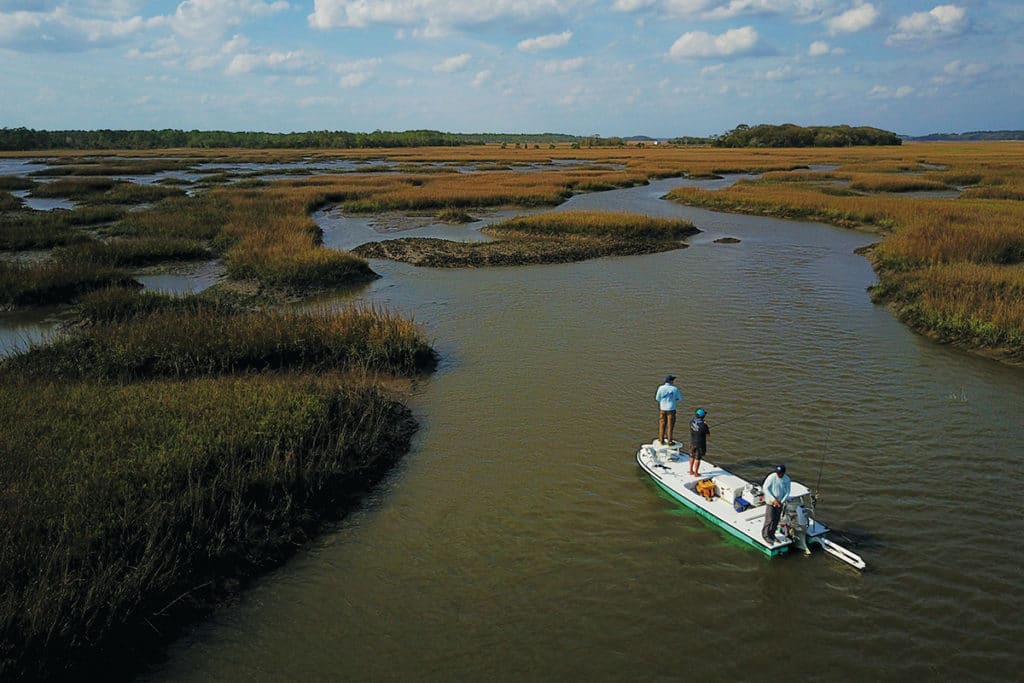
Exploring new inshore waters is downright intimidating, but it’s something we all face when fishing. The chance to run aground, get lost, fish the incorrect tides, explore the wrong areas or never see a fish, these are all among the many ways we might end up spinning our wheels. Paying attention to their surroundings, reading the tides, searching out moving water or skittish baitfish and using general fishing knowledge should help anglers pinpoint the productive waters.
That was my mindset in March when I headed to St. Augustine, Florida. I had help from Capt. Tim Jarvis, of Three Lagoon Fishing Charters, to explore and fish the estuarine waters of the Tolomato River. Jarvis previously had scouted the tributary creeks and marsh habitat for customer trips and tournaments, so he had a plan to attack the sprawling landscape of cordgrass, muddy shorelines, creek mouths, oyster bars and deep river bends.
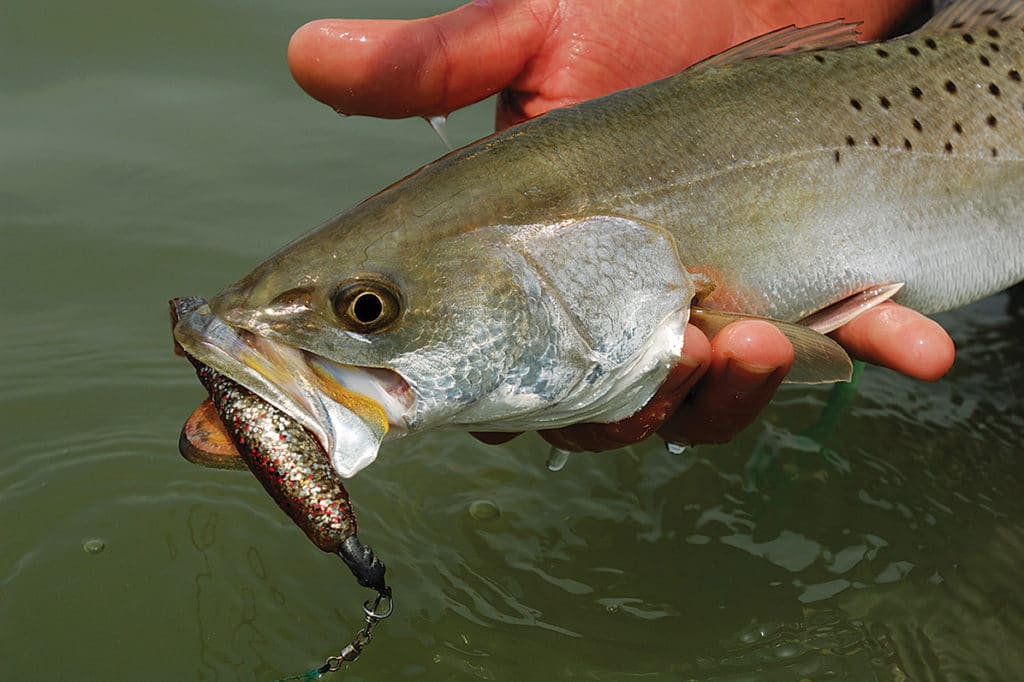
His plan, in general, is a solid starting point for anyone fishing shallow-water marshes:
“We’ll start by fishing a couple of [10- to 20-foot-] deep holes with good current movement,” said Jarvis as we motored away from the Usina Boat Ramp. “Then, we’ll head to some back-bay areas where I’ve seen schools of redfish. There are plenty of creek mouths and shorelines that also hold fish like flounder and seatrout, depending on the tide.”
Jarvis’ East Cape Lostmen fought through the choppy river waters until we finally reached the mouth of a tributary about the width of a soccer goal. From there, Jarvis slowly motored us safely upstream to a specific river bend that featured oyster mounds, heavy current and a carved-out deep hole. There, he deployed his Power-Pole anchor near some oyster beds.
“Last week the trout were here thick on the incoming tide,” he explained. “But you had to let the jig fall all the way to the bottom or they wouldn’t hit it. There’s at least 15 feet of depth right here, although it sure doesn’t look like it in the [stained] water. Most seatrout in the marsh average 20 to 21 inches — don’t expect too many big ones.”
Explore the Marsh at Low Tide
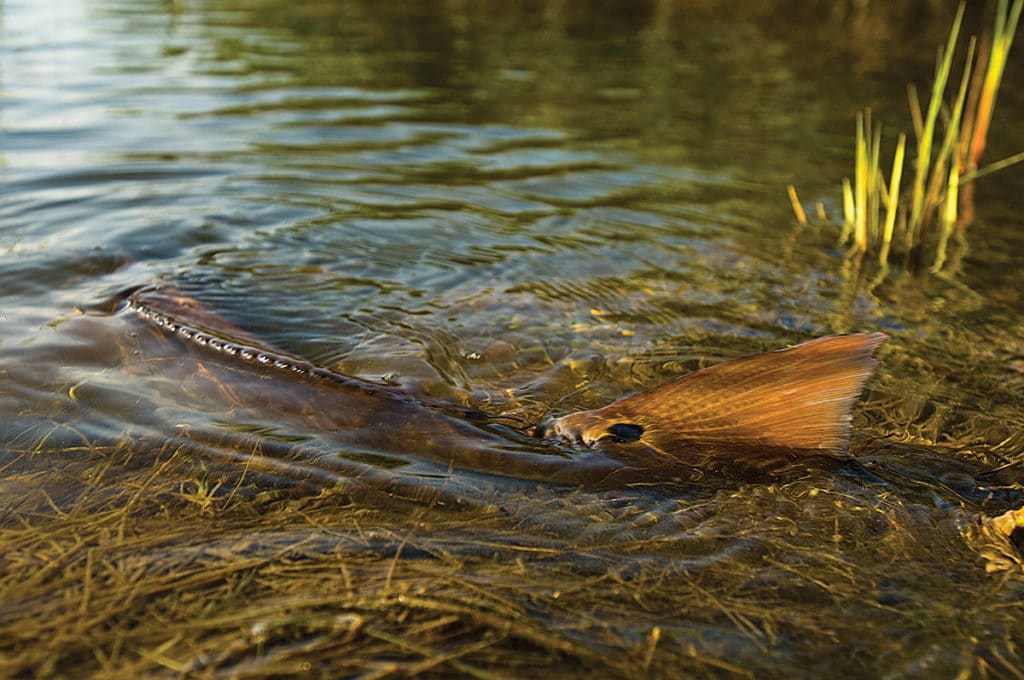
Deploying the trolling motor, we made our way toward a shoreline split by a couple of different feeder creeks. Nearby, we heard a prop plane take off from the Northeast Florida Regional Airport.
I cast a Cajun Thunder popping cork with about 4 feet of trailing leader that ended with a Storm 360GT Searchbait. The soft bait is composed of a rattling jig head and natural-swimming body that looks similar to an oversize mud minnow.
Soon, my egg-shaped cork dived firmly toward the bottom. I pulled back hard on the rod, only to see a nice-size speckled trout somersault near the water’s surface and spit the hook. Behind all the action, I noticed a ledge of mud filled with fiddler crab holes. Stalks of marsh vegetation poked out the top like spiky hair.
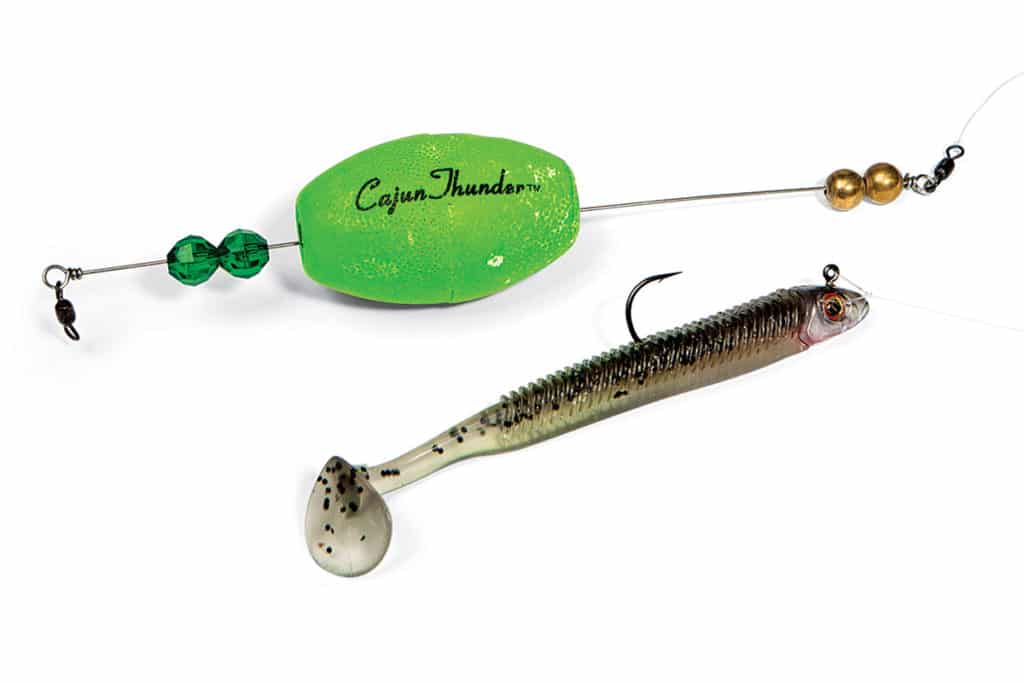
“That must be at least 2 feet of tide,” I said, pointing at the bare, sloping shore in front of us. (I later found out the area is influenced by as much as 5 feet of tidal movement in one cycle!)
“At least that much tide,” Jarvis said. “That’s why I always explore these waters first on the low tides. I know where I can and can’t go, and I won’t get myself stuck in the back of a dry creek. You can end up stranded all night if you’re not careful.”
The water flowed hard and fast throughout the marsh, replacing bone-dry creeks with navigable waters, only to turn back to mud over time. Seeing the topography of the area during low tide provides vital insight for anglers at high tide.
Learn where your boat can and can’t go on plane — or poling — at low and high tides. Pinpoint the locations of oyster bars hidden at high tide. Take notice of the depth of feeder creeks you fish — even at high tide maybe there isn’t enough water for some creeks to hold fish. Find out which areas have optimal water movement at different tide periods. And most important, fish high, low and all tides in between to track and learn how fish position, move and react during the different tide periods.
Make Lots of Casts to Cover More Water
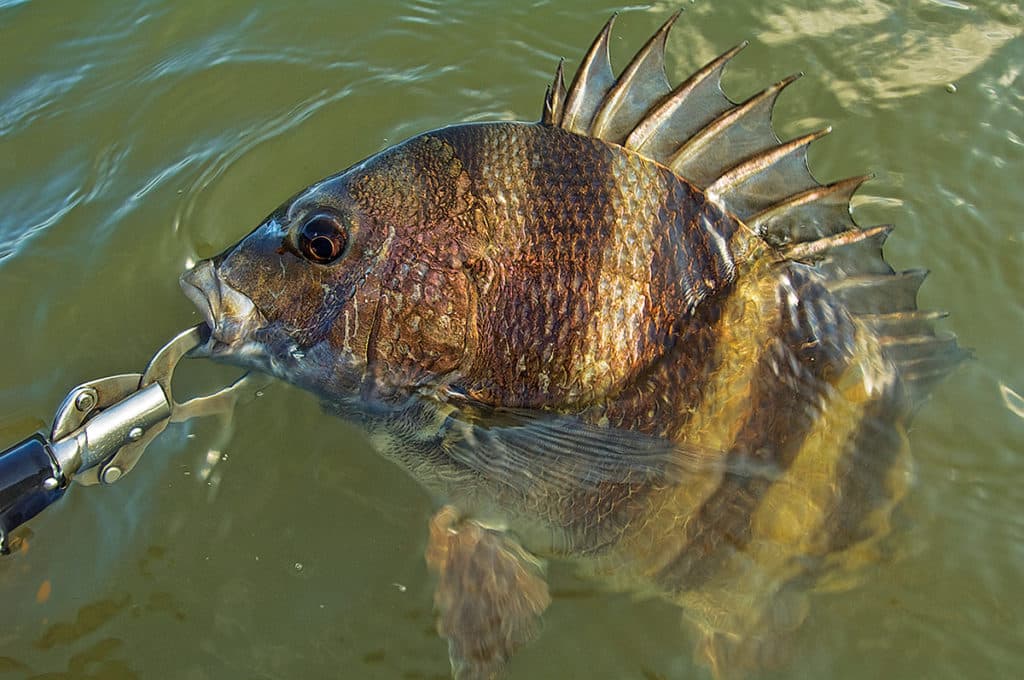
The tide poured into a back bay that featured islands of marsh grass and plenty of productive-looking shoreline. Surrounded by modest stucco homes, we cast at shorelines flooded from the incoming tide. Long wooden walkways split up the marsh into intervals, ending with worn-out docks, many of which were destroyed by hurricanes.
“Last week, I spotted a couple different groups of redfish in this area,” said Jarvis. “This is when I really like to throw weedless jerkbaits. I’ll make a lot of casts too, but thankfully casts are free. Look for the reds far into the [reeds], and for swirls, V-wakes and other movement away from the shoreline too.”
We pulled in our popping corks and tied on worm hooks; Jarvis likes to use jerk shads from Berkley Gulp! because of the additional smell attraction. While beating the banks, Jarvis leaves out a chunk of blue crab on another rod for redfish or black drum to find.
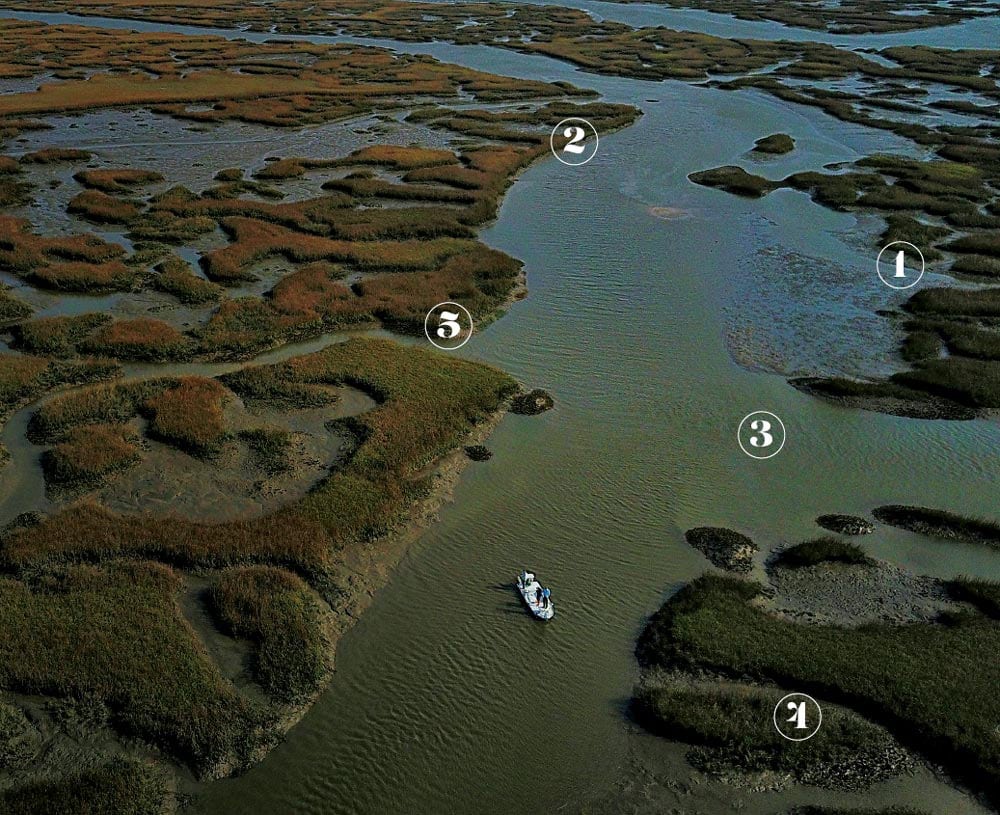
Marsh Hot Spots
Jarvis’ earlier scouting trips panned out for us this day.
Casting to a sprout of grass at the mouth of the bay, I pulled tight to a healthy redfish. The fish raced through the grass and all over the flat, only to succumb to my tightened drag and steady hand. I quickly boated him for a picture. Soon, angler (and Sport Fishing photographer) Jason Arnold, from Fort Lauderdale, hooked into a redfish that was cruising a shoreline. The fish was not particularly tight to the shore even during the higher tide. Fan-casting the entire area by all anglers on the boat helped pinpoint where the fish were positioned within a bay.
Still, one proven technique that’s popular from South Carolina’s Lowcountry south is to fish tight to grass shorelines on high tides. (The tides don’t have to be massive full-moon tides, but the extra depth helps.) Water floods in and around the reeds and grass, and as long as there’s enough water to cover fish, drum rush right in, looking for shrimp, crabs and even snails. A bouncing and bobbing piece of marsh grass signals a fish is munching on something attached to the plant’s base.
Anglers with a boat capable of quiet stalking should pole along the edges looking for tailing and feeding redfish. When the tide starts to fall, the reds will push out of the reeds. This is an opportunity for anglers to set up shop at choke points to cast to fish receding with the tide. We didn’t catch any fish back in the grass, although we sure tried. I believe the tide never rose high enough for the redfish to go exploring. But we did catch a handful of reds as they escaped from the back bay back out into deeper creek channels.
Use Tide and Current to Your Advantage
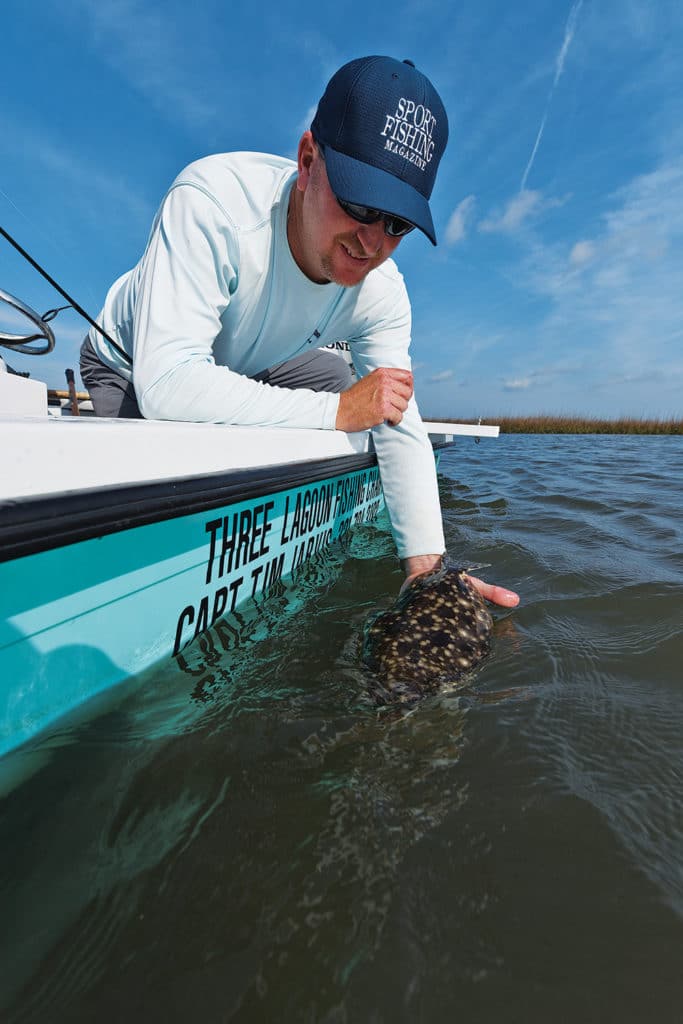
When tide is at its peak or plateau, finding moving water can be tough. Most anglers know that water movement allows game fish such as drum, flounder, snook, trout and stripers to position into the flow and wait for food. Current or tide is a dinner bell for game fish to feed.
As a general rule, I head downriver at low tides to find moving water. On the other hand, when the high tide turns, I want to be upriver.
Throughout the morning, we drifted different shoreline edges that were affected by water movement. Along one particular shoreline, I saw oyster bars shaped by a heavy tidal flow that eventually dumped out onto a sandy strand of hard bottom. I cast a lead-head jig into a depression among the oysters, then let the jig fall to the bottom to slowly bounce it with the current.
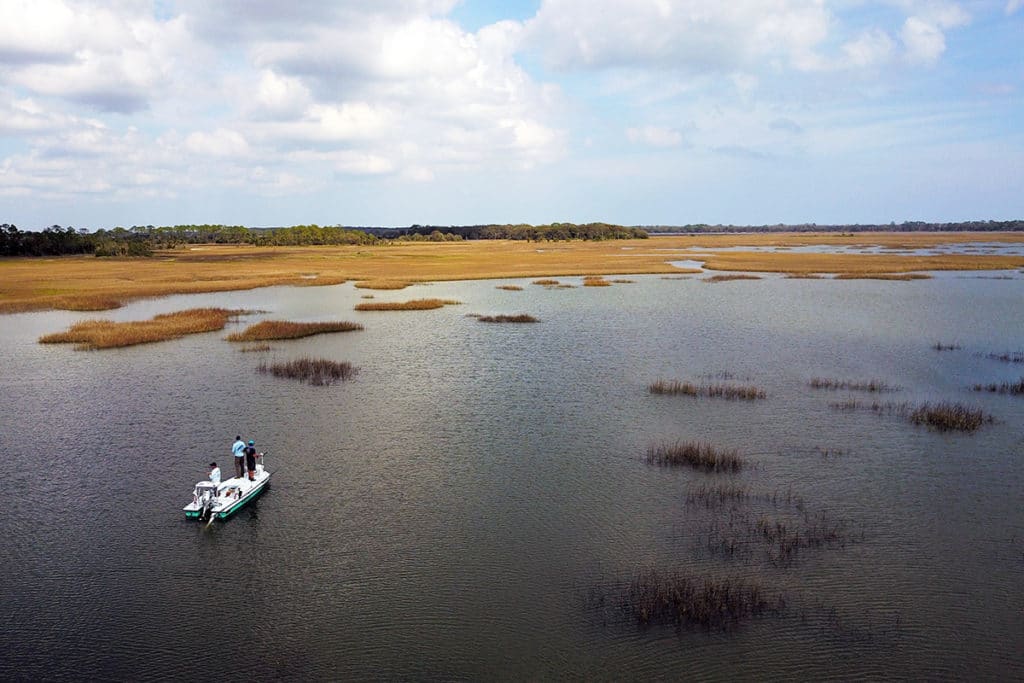
A flounder couldn’t resist my offering. It hit with such a soft touch that I wasn’t quite sure I had a fish. Jarvis thought I had an oyster. (Just seconds before, he had cast to the same area and accidentally hooked a chunk of oysters that pulled just like my flounder.)
Our boat caught speckled seatrout, redfish and flounder, drifting and trolling with the current. Prospecting allowed us to cover lots of water. A mass of redfish Jarvis found a couple of days before never materialized in the area, so we switched to covering water and casting to solitary fish.
A couple of considerations about moving water: Too much current will push fish out of a specific area if they can’t find ambush points. Look for ambush points slightly out of the current, protected by a bar, edge, point or other structure. Cast your lure or bait so that your presentation flows by the fish naturally. I don’t know how many times I’ve seen anglers cast down-current only to reel their lure back against the current! Many times, they are casting with the wind, so I don’t necessarily blame them. Still, retrieving a lure against the tide is an unnatural presentation that lowers your odds of enticing fish.
Estuaries Don’t Always Have Monster Fish
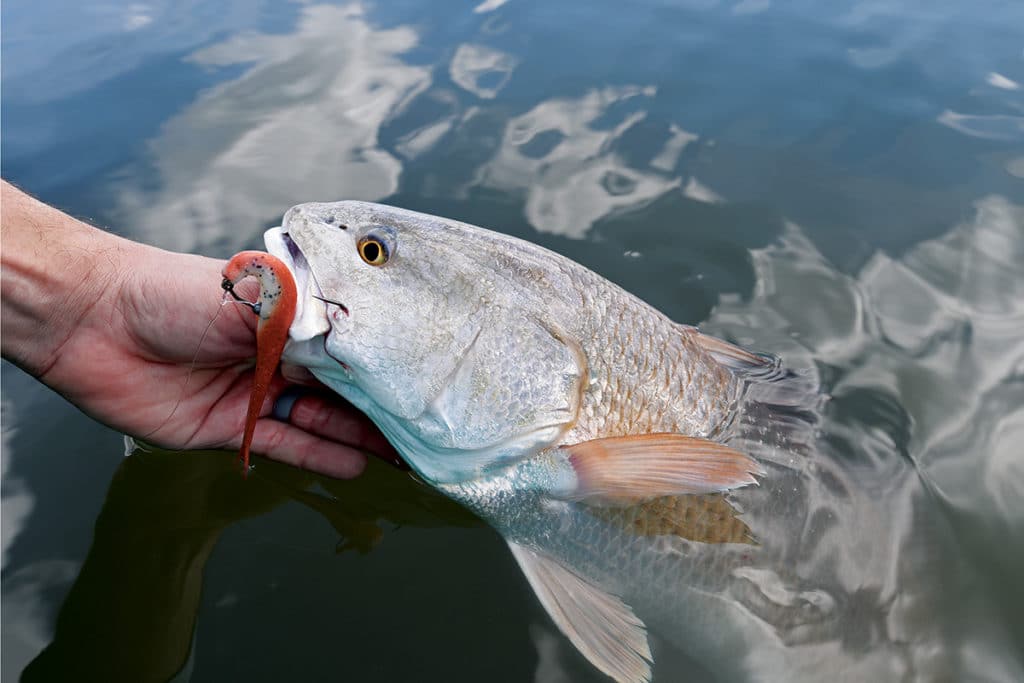
Although we caught a fair number of fish throughout the day, Jarvis pointed out that probably only one of our redfish catches would measure in a tournament. His point was that anglers shouldn’t expect to catch tons of giant fish back in the marsh. Instead, estuarine nursery environments are for juvenile game fish to eat, grow, develop and eventually move out to bays, rivers, inlets or even offshore.
“Flounder move in from offshore waters inshore when the water warms in the spring,” said Jarvis. “And we catch a lot of them back here. We are a little too early right now in March.”
The outer marshes that buffer Louisiana from the Gulf of Mexico are unique in being home to giant redfish. That’s more of an exception than a rule when it comes to marsh fishing. The largest freshwater river in the United States empties into the Gulf at the tip of the state, creating prolific growing and breeding grounds.
Most marshes simply won’t have those fishing opportunities. Still, marshes have plenty of prospects, enough big fish to keep you looking and a couple of surprises along the way. At one point, Jarvis made a cast at what we thought was a cruising shark. He cast the jig in front of its nose, enticing a strike. The fish hugged the bottom, only to finally reveal itself as a stingray. That was the first time I ever saw a stingray hit an artificial lure. Besides the big three species in St. Augustine — trout, redfish and flounder — other species, such as sheepshead and even baby tarpon, find their way back into the marshes. I had to ask Jarvis about my favorite Florida species, the snook.
“I have never caught a snook in St. Augustine, but we catch a lot of them at Sebastian Inlet south of us,” said Jarvis. “I have heard reports of snook being caught farther north of us in Jacksonville. Warm winters allow the fish to move north in Florida, although they’re never very big fish.”
Find Deep Water and Holes
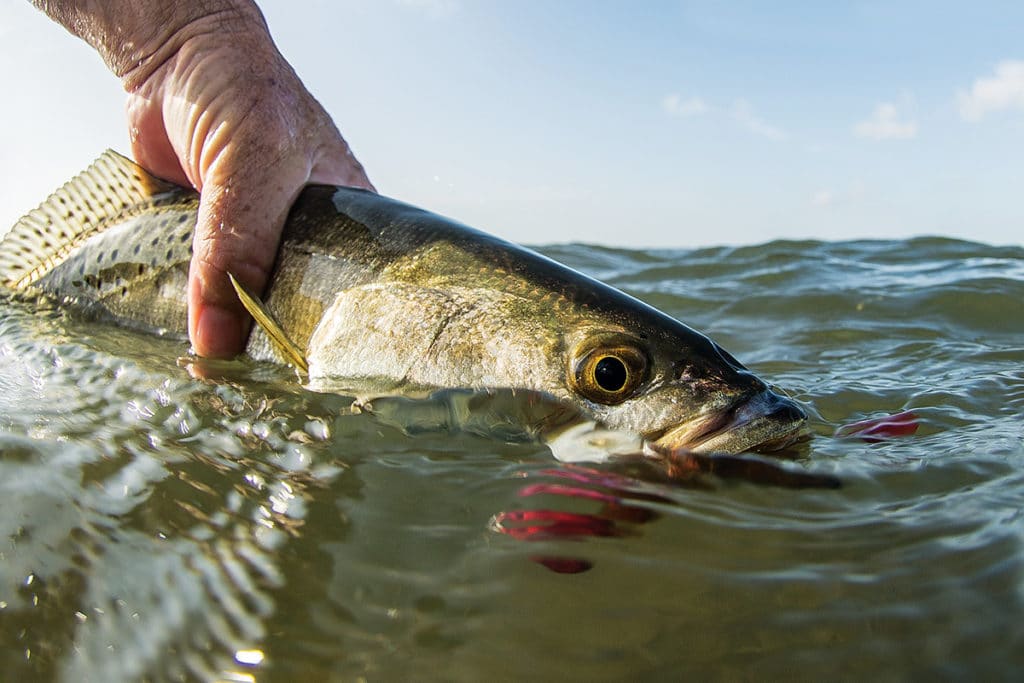
As the day finally started to wind down, Jarvis took us to one last spot. It was just one of the many holes that he knew about in the area. The hole had to be at least 10 feet deep, but the creek itself wasn’t wider than 20 feet. He posted us up on a shallow point and set the power anchor.
“There are so many of these deep holes [in some marshes], and I always seem to catch fish in them,” said Jarvis. “It’s a great backup plan.”
With his clients, often he uses live shrimp, chunks of blue crab, mullet or mud minnows as bait. We tried mud minnows, blue crab and shrimp throughout the day too, but didn’t fare any better than when casting artificials. Jarvis adds weight as necessary to get the natural baits down deep, often simply pinning a bait to a jig head.
What is so productive about deep holes is that game fish use these areas as a refuge when the tide drops. There’s enough water for them to feel safe and comfortable, even at low tide. With little tide movement, we were able to catch flounder and seatrout from one hole at the mouth of a creek. Jarvis often catches sheepshead, too, if he soaks a fiddler crab.
Probably the one pitfall to fishing marshes is that all the habitat looks too fishy. We ran into that exact problem throughout the day. We likely could have caught a couple more fish if we stuck to fishing choke points, oyster bars, larger creek mouths and deep holes. Some shorelines produce, others don’t — fishermen can spend too much time on a fishy-looking shoreline with nothing to show for it. But rigid compliance in fishing takes the fun out of the hunt. And you see some pretty cool things while hunting new waters in marshes, whether that’s oysters spitting at low tide, manatees chomping on vegetation or a bruiser redfish tailing in a dead-end creek that no one’s fished for weeks.








